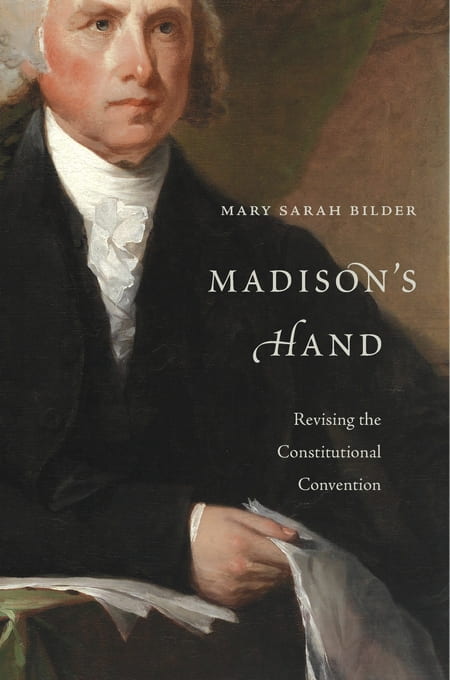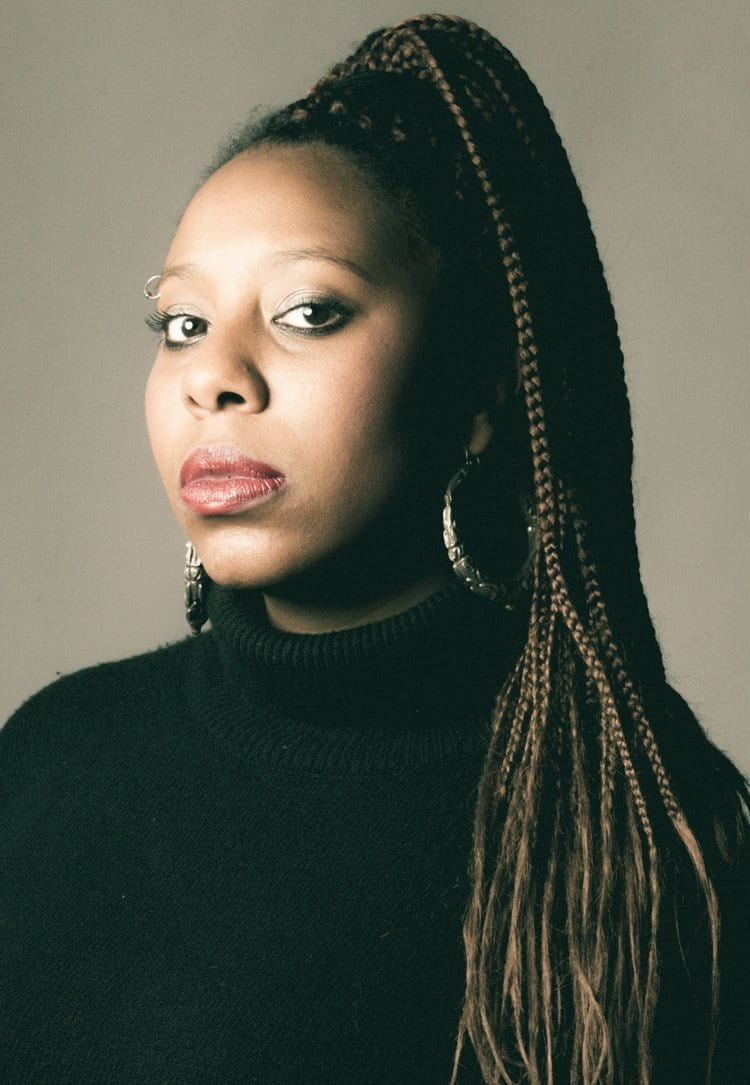
Mary Sarah Bilder, Madison’s Hand: Revising the Constitutional Convention (Cambridge: Harvard University Press, 2015).
Derek
When James Madison died in 1836—last of the men present at the 1787 convention that wrote the U.S. Constitution—his Notes of Debates in the Federal Convention of 1787 fell into the hands of Dolley Madison, his wife, to be published under her “authority and direction”–with Madison’s “entire confidence in her discreet and proper use of them.” (235). Congress soon purchased them, along with his other papers, for $30,000, and published them in several volumes. In her fascinating, very close reading of Madison’s writing and re-writings of his Notes in Madison’s Hand: Revising the Constitutional Convention (Cambridge: Harvard University Press, 2015), Mary Bilder doesn’t linger on this concluding moment in the documents’ transit from early national Philadelphia to antebellum D.C. The bulk of the monograph is a study of how Madison’s Notes were forged in the older British genre of parliamentary diary–for his own rather than public use–before passing through the changing prism of how he came to understand the Convention and Constitution over the following decade. Bilder summarizes: “Madison understood his revisions as repeated efforts to create a record—his record—of what he saw as significant in the Convention. Yet each revision increased the distance between Madison’s Notes and the actual Convention” (4). The book is a meaningful source for readers wishing to retrace the debates and stakes at the convention on the ground, rather than an aerial or presentist perspective. For historians and other professionals, it offers a very welcome reminder and examination of the complex and shifting context in which one of Americans’ most important sources actually emerged.
Within this story of revision, transmission, and publication that Bilder unveils, I think it worth observing that as James was the last first-hand participant in the Convention to die, Dolley was the last spouse of these participants to receive the bequest of their personal papers. She thus figures among the numerous wives and daughters of American founders who found in their hands masses of documents accumulated by the leading figures of the Revolutionary generation. This occurrence was frequent in the antebellum. As historical societies emerged, collectors of manuscripts roved the country, and families hoped to curate the reputation of their Revolutionary ancestor, these women found themselves at the important juncture between private papers and public records. Some, as Dolley, collaborated to edit and then pass them through government sponsorship. Others edited and published such papers themselves. Others selectively released and withheld them. It’s one of the many, important spaces in the early U.S. where women writers of history could leave their imprint on historiography and historical consciousness in this period, a question best explored in the work of Nina Baym, about which there remains much to say.
Simon
In lectures and in seminars we’ve gotten used to asking history students to think about their research as an effort toward answering some question, which takes quite an effort to articulate in the first place. In a recent essay on historians’ engagement with public audiences, the political theorist Corey Robin insists that it is precisely in their capacity to pose such original questions that historians can contribute to public discourse. They ought to aim “not to provide different answers to the same questions but to raise the questions that aren’t being asked.” When we write the history of ideas, we don’t just frame our own questions, we also write about thinkers as if they’re posing and answering their own. The philosopher Hans Blumenberg thought that it was questions, rather than the ideas that answer them, that continually persist through time to make intellectual history possible. There’s no getting away from questions when we think about the history of ideas, and in her recent book the historian Holly Case turns to intellectual history to help us understand why that might be.
In The Age of Questions (Princeton: Princeton University Press, 2018), Case traverses the “extremely long nineteenth century” to account for why so many journalists, philosophers and politicians in Europe came to embrace the question-form as the appropriate framework for seemingly every debate. In this century appeared the Jewish Question, the Polish Question, Social Question all to the much lesser known Dentist Question (you’ll have to read the book to find out what that was all about!). The sweep of Case’s account is impressively panoramic, and that panorama reinforces her argument that the popularity of the question-form cannot be explained by the resonance of one nineteenth-century debate alone, whether over nationality, emancipation or war. She shows how across these arguments the question-form encompassed conflicting and contradictory answers, but in all cases it allowed thinkers to imagine the possibility of reconciling their ideals, of equality or freedom or peace, with stubborn reality. In this way, Case suggests that the prevalence of questions marks a deep shift in the way people thought about the relationship between ideas and society, through history and projected in the future, over the course of the nineteenth century. It is a bracing account that offers a model and encouraging example for histories that trace epistemological assumptions and conventions that have become so pervasive that it’s hard to imagine a history behind them. It should lead historians, and particularly intellectual historians, to wonder how much our own thinking about ideas and society in the past and future remain within the bounds of the age of questions.
Pranav
Amongst early modernists, the “seventeenth-century crisis” is now a widely accepted formulation for describing various developments in 17th-century Europe under a single framework. In Hugh Trevor-Roper’s original summation, it denoted the general breakdown of social and political order all across Europe that led to the Thirty Years War, the British Civil Wars, the Fronde and various other contests for social, religious and political power. However, while most historians agree with the essence of the formulation, there is little consensus on what caused this general collapse of order. For instance, while several historians, Jonathan Scott for example, like to think of the British civil wars as another chapter in the wider saga of the Thirty Years War, other historians continue to insist on the uniqueness of the British conflicts.
In their scale and complexity, the European wars of the 17th century are simply baffling. However, in his Global Crisis: War, Climate Change and Catastrophe in the Seventeenth Century (New Haven: Yale University Press, 2014), Geoffrey Parker, noted historian of early modern Spain, has found a way of reinvigorating the “seventeenth-century crisis” framework and breathed new life into it. The result is an astonishingly ambitious book that ranges from England to Tokugawa Japan and covers most, if not all, parts of the globe. The book is remarkable for its wide research and the sheer audacity with which it tries to take on the task of the explaining the “seventeenth-century crisis.”
Inspired by recent research in environmental history and other fields, Parker makes a simple but bold claim. In his view, it was the Little Ice Age, the global cooling of temperatures that occurred roughly across the span of the seventeenth-century, that was at the heart of the multiple crises that troubled states and empires across the world. It led to failed harvests, severe droughts and a host of ecological problems that, when combined with simmering social, political, and religious tensions, boiled over leading to turmoil across the globe. Parker is no environmental determinist and his arguments are far more nuanced that they initially appear to be. While insisting on the essential threads uniting the various crises, he goes to great lengths to pay attention to the uniqueness of each episode. For example, he delves deep into Tokugawa history to explain how Japan was one of those places which “got it right” and didn’t suffer as much as the rest of the world over the course of the 17th century.
Needless to say, the book has a number of problems. For one, as Parker acknowledges, it is too long. There is too much on the specifics of each case that doesn’t quite add up to the final arguments. Similarly, as Ken Pomeranz has argued, Parker gets some things about Japan and China wrong in his analysis. While these errors may be enough to demolish any ordinary historical argument, they are nothing but minor issues in the face of the comprehensiveness of Parker’s work. Global Crisis is truly global history on the grandest scale, a rewarding read for historians in virtually every subfield.
Spencer
I am indebted to the brilliant Professor Brittney Cooper (Rutgers) for many things—inspiration, some extraordinary perspectives on time, space, gender, and race, two of the best academic talks I’ve ever seen—but looming large among them is surely introducing me to the work of Morgan Parker. For two weeks now I have been unable to get Parker’s incandescent, breathtakingly incisive verses out of my head, by turns lyrical and brutal, speaking to the darkness of contemporary America and speaking with a voice totally itself. Because, as Alan Bennett reminds us, “with a poem or any work of art we can never say ‘in other words’. If it is a work of art there are no other words,” I give you the first five stanzas of Parker’s gorgeous “The Book of Exodus“:
1
In this busted sailboat of a body,
I have never feared hovering sea fog.
I never stopped wandering in and out
of mouths, waving future in the air.
2
I am all the plagues at once: anxiety,
wine teeth, bad credit, general malaise.
Sometimes at a party I escape
to watch my lipstick fade in the bathroom mirror.
3
I rub my tongue until it bleeds. I become
a snake. I make you uncomfortable.
It becomes addicting
after a while. I get a taste for it.
4
Here I am presented in two parts:
a burning omen, a montage of flight.
I’m thinking glossy dream of highway, flowered
scarf trailing the dusty road of tribulation.
5
I’m thinking of taking a year off in Bali,
or whatever white folks are doing these days.
Going on a cleanse. Taking strange words fearlessly
into my pink mouth. Consider this my retirement.





1 Pingback